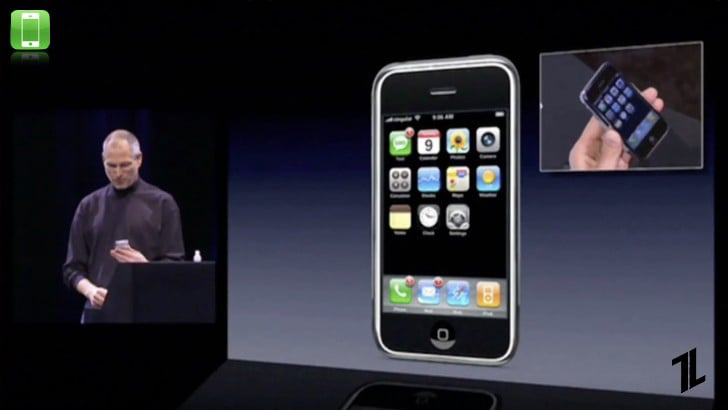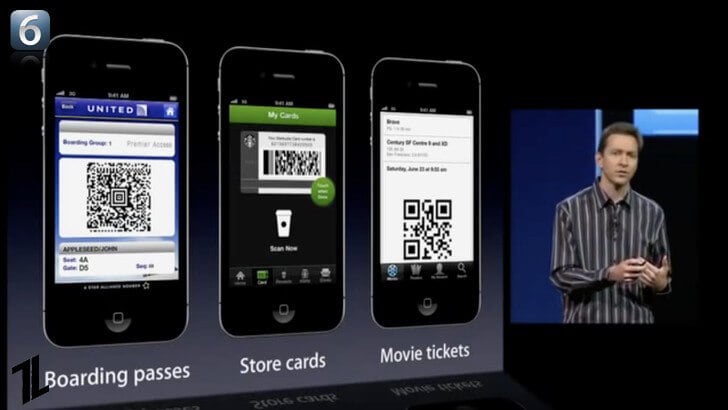While that may have been true, it’s easy to look back today and highlight everything that iOS didn’t have. You see, when it came to operating system development, Steve Jobs adamantly believed that you had to start humbly, focusing on the simple elements such as what a button would look like. Then build upon the solid foundation.
History of iOS
If we included every iOS feature you’d be here all week and probably bored to death, so we’ll only focus on the major stuff.
iPhone OS 1
Announced: January 9, 2007 Released: June 29, 2007 Apple’s original iPhone OS was a seminal achievement. Running a modified version of OS X, the Apple’s Mac Operating System, Apple’s engineers, had a number challenges ahead. Not only did the code base have to be reduced to a tenth of its size, during development engineers had to simulate chip speeds, and the impact on battery life as the physical chips would not be manufactured until much later into the development cycle.
Steve received his first of many cheers from the crowd early in the iPhone announcement ‘playing’ the audience: Today, we’re introducing three revolutionary products of this class. The first one: is a widescreen iPod with touch controls. The second: is a revolutionary mobile phone. And the third is a breakthrough Internet communications device. So, three things: a widescreen iPod with touch controls; a revolutionary mobile phone; and a breakthrough Internet communications device. An iPod, a phone, and an Internet communicator. An iPod, a phone … Are you getting it? These are not three separate devices, this is one device, and we are calling it iPhone. Initially, Apple used the three above associations to group iPhone OS features and to better resonate with consumers, after all, who on the planet didn’t know what an iPod was. The non-editable dock contained;
Phone – including Visual VoiceMail Mail – HTML e-mail Safari – web browser iPod – music/video player
While on its single, non-editable Home screen the following built-in applications were provided;
Text • Calendar • Photos • Camera YouTube • Stocks • Maps • Weather Clock • Calculator • Notes • Settings
Apple and Google weren’t competitors yet in this space, so the Apple Maps and YouTube applications utilized Google’s back-end services. Meanwhile, Yahoo provided the back-end service for the Weather app. Steve Jobs was also an advocate of Skeuomorphism interface design, with icons mimicking real-life objects and materials within the iPhone’s OS. This trend would peak with iPad apps containing leather stitching and paper textures. iOS 7 would later banish this to the history books. iPhone OS 1 introduced many of the concepts that we’re familiar with today including slide to unlock, multi-touch including pinch to zoom and badge notifications. What was missing? Famously, Text didn’t support the widely adopted MMS standard, you couldn’t search for the Contacts app, while Copy & Paste including other features such as wallpapers would be added in future iOS releases. Additionally, the majority of your content was synced via physically connecting to a PC or Mac via iTunes. Apple introduced new features rapidly during the lifecycle of iPhone OS 1. Headline additions included;
Home button double-click shortcut to phone favorites or music controls Space bar double-tap shortcut to insert full stop and space Maps gained the ‘Locate Me’ feature to determine the phone’s approximate location, using a combination of cellular triangulation and Wi-Fi data from Skyhook Wireless; also hybrid map support and the ‘Drop Pin’ feature Icons on the home screens got the option to be rearranged and placed on multiple home screens (up to nine). Web Clips could be added to (and subsequently removed from) the home screen SMS messages could be sent to multiple contacts using messages iTunes store debuted
iPhone OS 2
Announced: March 2008 Released: July 11, 2008 The headline feature for iPhone OS 2 was the introduction of Apps. Apple introduced its first SDK for developers, and the App Store for consumers provided a single point of entry to find and download apps. At launch, there were circa 500 apps available, while today there are several million.
Other notable changes included;
Full Push e-mail supporting mass move and delete Ability to view iWork and MS Office attachments in e-mail Multiple calendars support Separate Contacts app with the search for contacts Pictures downloads from Safari and Mail to Photos Parental controls Scientific calculator in landscape mode Google Street View for Maps; location sharing via e-mail Pressing the Home button from any Home screen navigates to the first Home screen Emoji support for Japan. Other countries can access via apps iTunes no longer restricted to Wi-Fi only
iPhone OS 3
Announced: March 2009 Released: June 17, 2009 During the lifecycle of iPhone OS 3, Apple launched the iPad resulting in Apple renaming iPhone OS to iOS. iOS 3.2 was launched alongside the original iPad. iOS 3 introduced the long-anticipated system-wide ‘cut, copy and paste’. A spotlight was introduced, providing a search including contacts, e-mail, notes, and apps. While the number of Home Screens was expanded to 11, allowing for 180 apps. Text application got renamed to Messages and gained support for MMS. Camera app gained auto-focus while video recording is now supported for the newly announced iPhone 3GS.
Other notable changes included;
Turn-by-turn navigation support Photos trimming within the Photos app and delete multiple apps Find My iPhone option for MobileMe Tethering over USB and Bluetooth
iOS 4
Announced: March 2010 Released: June 21, 2010 This was the first iOS release to drop support for older devices, namely the original iPhone and iPod Touch. Functionally, iOS 4 was notable for introducing folders onto the Home screen and supporting custom Home screen wallpapers. Fast app switching was introduced while limited multi-tasking features were also added along with background audio playback.
Other notable changes included;
FaceTime 5x digital zoom for the Camera app Unified inboxes in Mail Updated carrier signal strength display and updated method for calculating signal strength (fall-out from antennagate) AirPlay AirPrint via Print Center Multi-tasking tray supporting Volume controls, AirPlay controls, Brightness and screen rotation/lock switch Personal HotSpot
iOS 5
Announced: June 6, 2011 Released: October 12, 2011 Introducing Siri. iOS 5 brought Apple’s Digital Assistant (beta) to the world. Notifications got a substantial overhaul with temporary banners appearing at the top of the screen and all consolidated in the Notification Center. The iOS dependence on a computer was further reduced as System Software Updates could be downloaded wirelessly, while content could be synced via Apples iCloud web-services.
Other notable changes included;
iPad multitasking gestures Camera short-cut from the lock screen iMessage synced across iOS devices Group messaging iPod app removed, replaced by Music and Videos apps Volume up key as a shutter release Photos got built-in photo editing for a crop, red-eye, auto-enhance, and rotation Syncing content between devices via iCloud, including Photos, Contacts, Calendars, Notes, Reminders, Mail, Safari bookmarks, Settings and backups Full built-in Emoji support
This also marked the switch when Apple would announce future iOS releases at its World Wide Developers Conference (WWDC), a tradition that remains to this day.
iOS 6
Announced: June 11, 2012 Released: September 19, 2012 iOS 6 was infamous for the new Apple Maps app that replaced Google Maps providing 3D overviews, Satellite views, and Flyover for 3D satellite views. Data inaccuracies resulted in an open letter of apology from CEO Tim Cook and the departure of Scott Forstall. Siri further increased its reach by becoming available on the 3rd generation iPad and above, iPad Mini and 5th Generation iPod Touch. Boarding a plane would never be the same again as the Passbook app was introduced to manage boarding passes, tickets, loyalty cards and coupons.
Other notable changes included;
Siri further enhanced to provide information on sports, local searches around the world, movie information, ability to book restaurant tables, launch apps and read notifications. Eyes Free would be the first foray into the automotive world. Shared Photostreams FaceTime over cellular Panorama Mode
iOS 7
Announced: June 10, 2013 Released: September 18, 2013 Since it’s inception, iOS’s user interface had remained much the same and was starting to age in comparison to Android. This changed at its seventh major release. Under the guidance of Jony Ive, Apple’s senior vice president of design, iOS 7 introduced a substantially redesigned flat user interface and constructs that permeated throughout the whole of iOS. Goodbye skeuomorphism. Also, iOS 7 added a new Notification Center, while the new Control Center provided fast access to the most commonly used controls and features. iOS 7 was oft-criticized for being design-led as opposed to productivity focused, with usability hampered by needless animations and lack of consistency.
Other notable changes included;
AirDrop for wirelessly sharing content between Apple devices CarPlay Siri redesign and new voices New system font New system-wide back navigation gesture, swipe from the left edge of the screen Spotlight Search available on all Home screens Redesigned app switcher with a new swipe to close gesture Dynamic wallpapers and Parallax wallpapers Block list for the Phone app FaceTime Audio iTunes Radio Camera app with 120 fps video recording for supported hardware
iOS 8
Announced: June 2, 2014 Released: September 17, 2014 After the significant redesign, iOS 8 was a polishing update, mopping many of the outstanding issues. It also brought together Apple’s iOS devices and Mac computers by introducing Hand Off and Continuity features. Those allowed tasks started on one device to be picked up seamlessly on another. Answer a phone call on an iPad or Mac or send and receive SMS/MMS messages on an iPad or Mac. Apple Pay launched with the iPhone 6/6 Plus. Later releases of iOS 8 would bring support for the Apple Watch and the launch of Apple Music. The HomeKit framework was announced providing support at an OS level for smart-home appliances and automation. Apple also introduced Metal, a low overhead 3D hardware accelerated API providing improved performance for graphically rich games and applications.
Other notable changes included;
QuickType iCloud enhanced to support Photo Library and iCloud Drive Voice messages within Messages New gestures for deletion, flagging or moving messages in Mail Support for third-party widgets in Today view Flyover City Tours for Maps Hey Siri for when a device is plugged into a power Wi-Fi calling Weather data provided by The Weather Channel
iOS 9
Announced: June 8, 2015 Released: September 16, 2015 A new system-wide feature providing Proactive assistance was introduced, though Siri and advanced search, users are now presented with contextually aware information. The Notes app within iOS 9 received notable (pun intended) updates with the ability to add photos, hand-drawn sketches, different fonts within a note. Apple added a new app called News, providing curated lists of personalized news content for iOS users, offering content from favorite websites and newspapers The iPad multitasking experience was improved by the introducing Slide Over, Split View and Picture in picture. 3D touch came providing ‘peek’ & ‘pop’ functionality, while Night Shift made the display color warmer for more comfortable viewing in the evening.
Other notable changes included;
Search for settings Wallet replaced the Passbook app Low Power Mode Upper/Lowercase keyboard Wireless CarPlay
iOS 10
Announced: June 13, 2016 Released: September 13, 2016 iOS 10 brought raise to wake as well as a new lock screen with gestures for accessing the camera and Today view. Support for third-party VoIP for receiving calls on the Lock screen was also part of this release to keep up with the times, while the new iPhone 7 Plus introduced creating a fake bokkeh called Portrait mode.
Other notable changes included:
The option to hide the majority of the built-in apps A new look for Maps Face recognition for the Photos app New Home app for controlling HomeKit accessories All new design for Apple Music Control Center redesign 3D Touch extended to support Lock screen notifications Find My AirPods added to Find My iPhone app
iOS 11 – Current release
Announced: June 5, 2017 Released: September 19, 2017 Control Center was redesigned the last time Apple updated its mobile OS, bringing all controls together on one page and adding support for 3D Touch. The Lock screen and Notification Center got combined, while the App Store was completely redesigned. Augmented Reality apps got kick-started through ARKIt. Apple Pay Cash debuted in the US, while the new iPhone 8, 8 Plus and X Apple introduced Studio Lighting into the Camera app. Later releases introduced support for the Apple HomePod and the iPhone Battery Health (beta) feature. Later iOS 11 beta’s have introduced AirPlay 2, Apple’s next-generation robust multi-room device streaming protocol. iOS 11 had one of the slowest adoption rates of any previous iOS version and has been criticised for its battery life on iPhones that are only 1 or 2 generations old and for a number of high profile bugs.
Other notable changes included:
New Files manager app New Siri voices Photos enhanced to include new Loop, Bounce and Long Exposure effects for Live Photos Enhanced iPad experience including all new dock, enhanced Slide Over and Split View and drag and drop between apps
iOS 12 The future – what we expect
Well done for making it this far, we tried to keep it as short as possible but the breadth of the subject matter made it all but impossible. That’s why we felt we’ll leave our iOS 12 impressions for another post that we’ll share with you next time.













